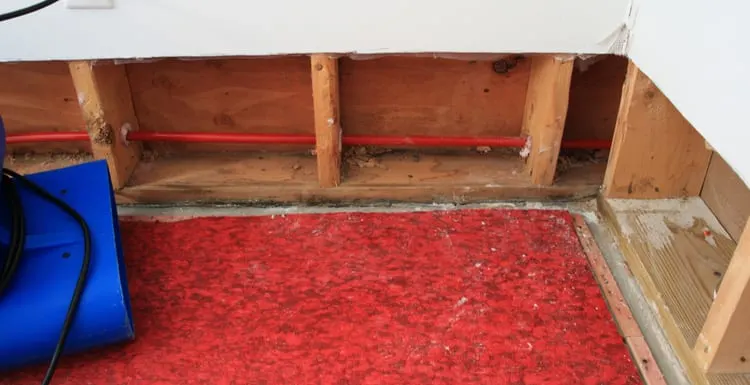After a flood, fibers in carpet can hold onto water beneath the surface and start molding.
Leaving carpet wet for too long—even 24-48 hours—creates a breeding ground for mold and mildew. This is why it’s important to know how to dry carpet quickly and properly.
Wet carpet needs your immediate attention to avoid long-term problems that become much more expensive and time-consuming to fix. Luckily, drying carpet is simple, and by taking the correct steps, you can ensure mold never has a chance.
There’s no need to buy all new carpet when fresh air, water extraction tools, and a few tips and tricks can have your carpet dry in no time.
We’ll show you how to easily and thoroughly dry carpet to keep mold and mildew at bay and make cleanup a little easier.
How to Dry Carpet: A Step-by-Step Guide
Once your carpet is soaked with water from a plumbing problem, flooding, or storm surge, work quickly to give your carpet the best chance at drying before mold has the opportunity to take hold.
Using water extraction and air-moving techniques, you can speed up the drying process. Follow these steps to begin drying wet carpet right away.
1. Cover Up
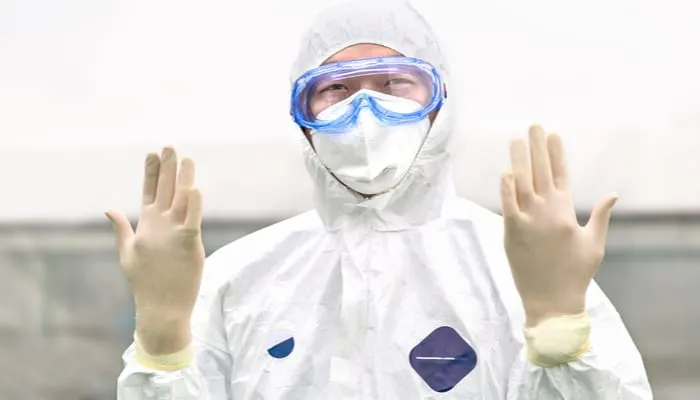
Eugene Lu/Shutterstock
Put on protective clothing to avoid contact with what could be dangerous floodwater containing sharp fragments, bacteria, animal and human waste, harmful chemicals, or disease.
Rubber gloves, rubber boots, and goggles offer the best protection, according to the Center for Disease Control.
You may want to wear a special N95 mask if you believe there is a chance mold has already grown in the area where you’ll be working.
2. Ventilate the Home
Open windows and doors in the home to create cross-breezes that will speed up drying time.
But if it’s rainy or humid outside, skip this step and run the air conditioner or central heating system instead. Bring any fans you have inside. Then, turn on all ceiling fans in the home to keep dry air moving.
3. Run a Dehumidifier
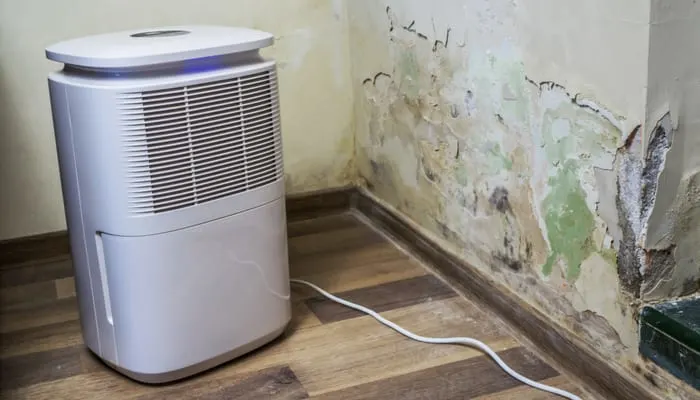
Theodor Negru/Shutterstock
Run a dehumidifier in the area to remove excess moisture from the air and prevent it from settling back into the carpet as you dry it.
Be sure to empty the canister regularly as it fills with water.
4. Soak up Water
Dry towels will soak up much of the excess water. Lay as many towels as you can find on the wet carpet and apply pressure to soak up more water. Once a towel is completely soaked, wring it out and switch it with another dry towel.
This will take care of most of the excess water, but the padding underneath the carpet will still be damp. It’s important not to skip this step because you don’t want a puddle of standing water sitting around.
5. Vacuum the Water
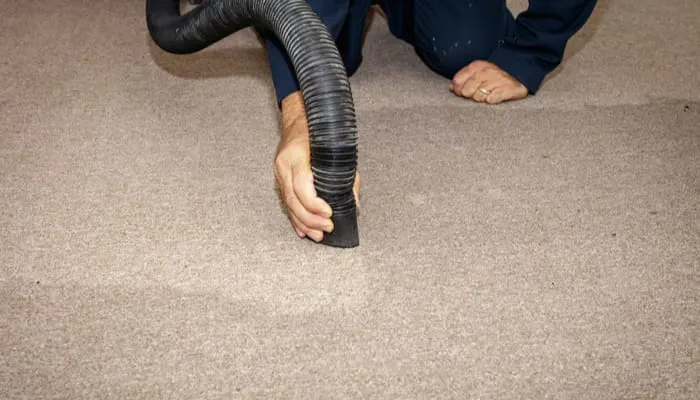
Jens Lambert/Shutterstock
If power is available, use a wet-dry vacuum to remove water trapped in the carpet padding and fibers.
You can rent these vacuums from stores like Home Depot or buy one for anywhere from $20 to $100. Make several passes over each area in straight lines, emptying the canister of water in between.
6. Apply Baking Soda
Liberally sprinkle baking soda on the (mostly dry) carpet and let it sit for at least half an hour, up to 24 hours, before vacuuming it up. The longer it sits, the more effective it is.
Baking soda absorbs liquid and odors, making it one of the most cost-effective ways to keep mold from growing in and under your carpeting.
Don’t apply baking soda when the carpet is still wet. It will cake up and make it much harder to remove.
7. Check the Carpet
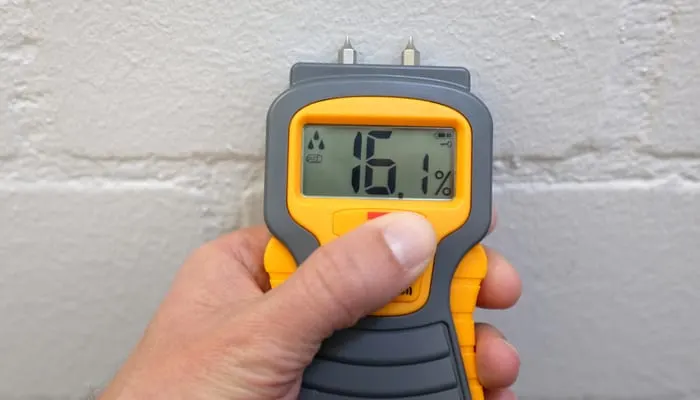
Eugen Thome/Shutterstock
After completing steps 1–6, use a moisture meter to see how damp the carpet is. Press a paper towel into the carpet or use a moisture meter, which gives a much more accurate reading.
To use your moisture meter, you will need a dry sample to compare your damp carpet sample to. You can use carpet in an unaffected area of your home for this.
If your dry material (carpet, for example) reads 33 on a 0-100 scale, and another sample of the same type of material reads 56, then that second piece of material is at least slightly damp.
– Moisture meter manufacturer Delmhorst
If your moisture meter uses color coding for readings, aim for readings in the green area.
Those in the yellow or red areas are still quite damp and have high potential for mold growth. You may be able to test the drywall and wood surfaces of your home with these meters, too.
8. Steam Clean the Carpet
Steam clean the affected areas to deodorize and sanitize. The high heat used to create steam for carpet cleaning kills bacteria and keeps mold from thriving.
You can rent a steam carpet cleaner for around $30 per day.
9. Sanitize the Surfaces
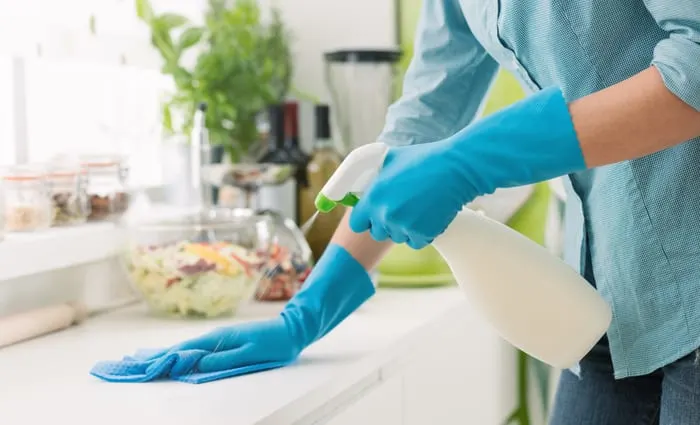
Stock-Asso/Shutterstock
Sanitize all affected surfaces with water-diluted bleach. This includes baseboards, other flooring, walls, and any household surfaces that came into contact with water.
Pour 1 1/2 cups of chlorine bleach into 1 gallon of water. Wear gloves, and be sure to mix the solution in a well-ventilated area.
10. Move Your Items
Move furniture back in only once everything is thoroughly dry. Danny Lipford, owner of Lipford Construction and host of Today’s Homeowner, says the most common mistake people make when trying to dry carpet is stopping the effort too soon.
When everything looks and feels dry, it probably is on the surface. There may still be a lot of dampness underneath. You need to keep a dehumidifier and fans running 24 hours a day for at least a week after the water damage occurs.
This longer drying process ensures everything is free from mold-causing moisture, inside and out.
Can Padding Be Completely Dried?
Different sources seem to disagree on whether or not carpet padding can be completely dried after getting soaked. Some say that with a thorough drying process like the one outlined above, you can dry both the carpet and padding.
However, it is possible to dry wet carpet and still have moisture in the padding underneath without odor or any signs of dampness from above.
Carpet padding is like a sponge and will absorb a lot of water, but it will not dry out…if you were to reuse the padding, it would be damp and mildew, grow mold, and smell under the carpeting. -Carpet Renovations, Inc.
For this reason, it may be safest to pull up the carpet, dry it, and replace the padding using the steps below.
- Wearing gloves, pull up the tack strips that hold your carpet and padding in place. Remove the carpet and padding, then dispose of the padding.
- Lay the wet carpeting down flat without folds or bumps. Follow the steps 1–9 above.
- Once the carpet is completely dry, you can have someone come install new padding and reinstall your carpet.
While this is a way to dry carpet and padding, keep in mind that if it smells or is discolored, it should be replaced.
How Should You Dry Carpet?
Whether you choose to pull up the carpet and dispose of the padding or try to dry the carpet and padding together, you’ll be able to avoid mold and mildew growth by taking action quickly and employing these DIY carpet drying techniques.
When researching how to dry carpet, take the job seriously and be as thorough as possible to keep your carpet and padding from becoming moldy and odorous after getting wet.

